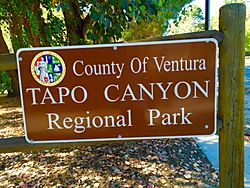Tapo Canyon facts for kids
Quick facts for kids Tapo Canyon Regional Park |
|
|---|---|

Sign by entrance
|
|
| Type | Open-space park |
| Location | Simi Valley, CA |
| Area | 210 acres (85 ha) |
| Created | 1969 |
| Operated by | Santa Monica Mountains Conservancy |
| Status | Open daily 07:30 AM to 8 PM |
Tapo Canyon is a beautiful area with many deep valleys, called canyons. It is located in the western Santa Susana Mountains in Ventura County, Southern California. This area is also a special wildlife corridor. This means it's a natural path animals use to move safely between different places.
Tapo Canyon Regional Park is a large outdoor park and camping area. The Santa Monica Mountains Conservancy manages it. The park is nestled among the many canyons and rolling hills in northern Simi Valley. Today, the park offers fun activities like mountain biking, horseback riding, and hiking. You can also find campgrounds, picnic areas, and places for RVs. The park's highest points are about 2,300 feet high. From here, you can enjoy amazing views along the hiking trails.
Contents
Discovering Tapo Canyon's Past
Geologists believe that millions of years ago, the Pacific Ocean covered much of Simi Valley. Only the tops of some mountains were visible. Scientists found a lot of ocean sediment in northern Simi Valley. This sediment is about 1,500 to 3,000 feet thick. It lines up with where Tapo Canyon is now.
The Chumash People and Tapo Canyon
The name Tapo Canyon comes from the Chumashan people. They called it Ta’apu. This was the largest of three Chumash villages in Simi Valley. The other two were Kimishax and Shimiyi. Shimiyi is where Simi Valley gets its name. The village of Ta’apu was next to Tapo Creek in Tapo Canyon. It was a busy village for thousands of years before Europeans arrived. Historians think Ta’apu might mean a sulfur deposit.
The last chief of Ta’apu was Zalasuit. He was later baptized as Salvador at the Mission San Fernando in 1804. Three Chumash people from Ta’apu survived the mission period. They were Tiburcio Cayo (1793-1844), Maria del Pilar Siguisalmeulgel (1807-1860), and Leopoldo Cuticucagele (1799-1865).
Many Chumash artifacts have been found in Tapo Canyon. One important find was a Chumash Effigy Tablet. Philip W. Gillibrand discovered it in 1900. The tablet is ten inches long and 6.25 inches wide. Historians believe it might have been a Chumash calendar.
Early European Views and Farming
A Roman Catholic priest, Father Vincent de Santa Maria, described Tapo Canyon in 1795. He wrote that the water was not plentiful. He also said the valley was narrow and the soil was salty. This meant it was not good for farming.
However, in the 1850s, a wine-maker named Don José De La Guerra started growing grapes. He made wine in his Tapo Canyon vineyards. By 1858, he moved his main operations to Tapo Canyon.
Modern Development and Park Creation
The population in Tapo Canyon grew again in the early 1900s. This happened when the Scrab Oil Company started producing oil there in 1910. The first oil well produced about three hundred barrels of oil each day. Soon, a pipeline was built to carry the oil to storage tanks. In 1916, Edward Doheny bought a large amount of land around Tapo Canyon. He paid $110,000 for the land and $250,000 for the oil rights.
Ventura County acquired Tapo Canyon in 1969. This is when it became Tapo Canyon Regional Park. In 1985, the Tapo Canyon Fire burned 16,000 acres of land nearby. Because of this and other wildfires, the park was closed from 2003 to 2008.
Exploring Tapo Canyon's Geography
Tapo Canyon is in the northern part of Simi Valley. It is part of the Santa Susana Mountains. The Santa Monica Mountains Conservancy manages it as part of Tapo Canyon Regional Park.
The park is a few miles south of Piru, CA. It is also about 4 miles west of Santa Clarita. Santa Clarita is a large city in nearby Los Angeles County. The area has rolling hills, covered with shrubs and bushes. There are also many canyons, oak trees, and creeks with plants growing along them. You can find Tapo Canyon Regional Park at 4651 Tapo Canyon Road in Simi Valley, CA.
Animals of Tapo Canyon
The animals in Tapo Canyon are well-suited to the dry climate. You can find different kinds of snakes and desert reptiles here. Since it's a wildlife corridor, many larger animals also live or pass through. These include mountain lions, coyotes, bobcats, grey foxes, and raptors (birds of prey). You might also see opossums and many other types of wildlife.
Scientists have found several fossils in the area. These include ancient animals like the Leptoreodon from the Paleogene period. They also found Boavus from the Eocene period.



